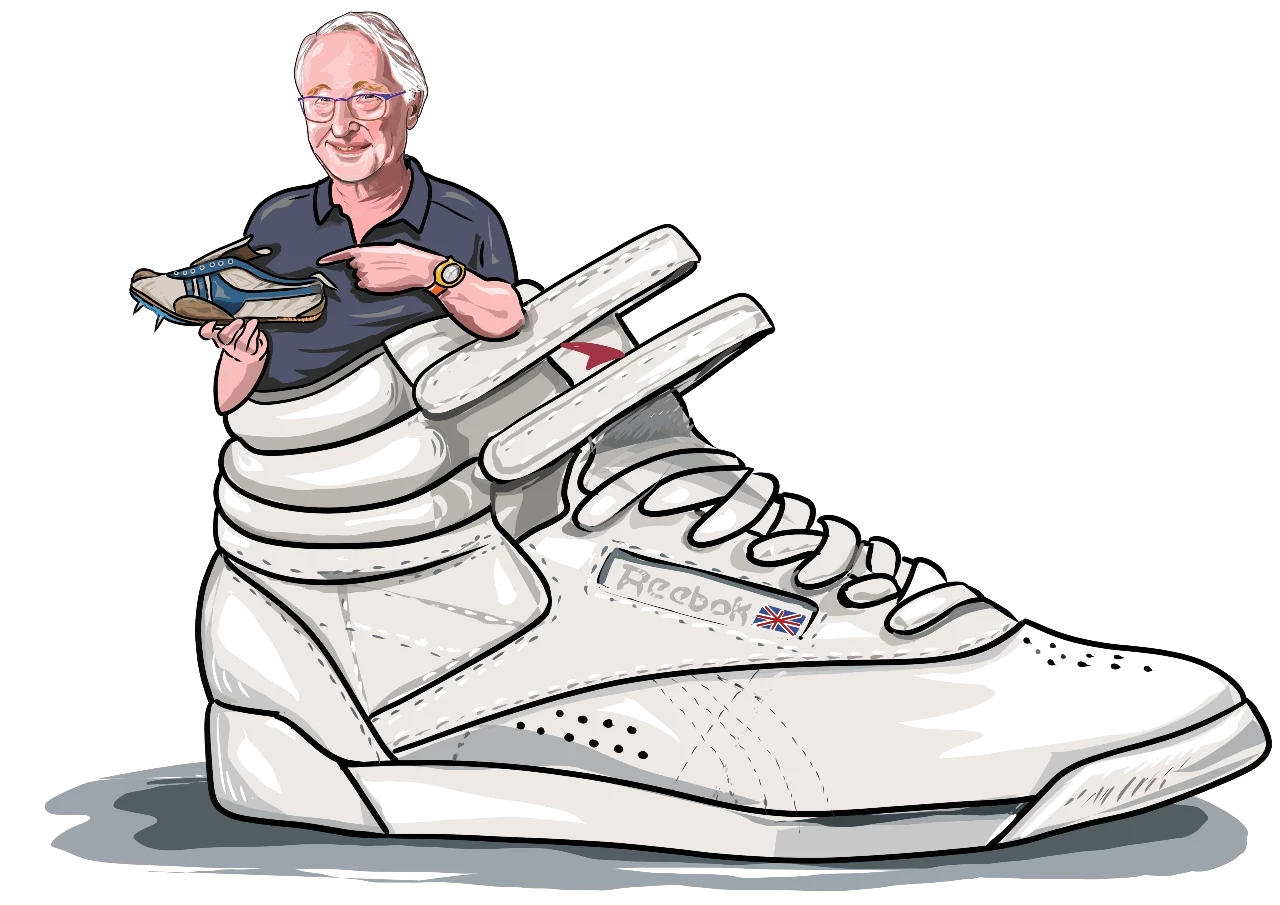Thinking Outside The Shoe Box


Jeff and Joe Foster founded Reebok running shoes in 1958. The industry wasn’t entirely new to the brothers in Bolton, England. Their grandfather’s company, J.W. Foster & Sons, had been in the business since 1895 and their shoes were worn by Harold Abrahams and Eric Liddell at the 1924 Paris Olympics where they won gold (and were later immortalized in the Oscar-winning film Chariots of Fire). Still, it took Reebok decades to break into the American market. Finally in 1987, thanks to the popular Freestyle model, they surpassed Nike as the most popular athletic shoe in the world. In this first of a two-part series, Joe Foster credits women for Reebok’s success.
MY REEBOK STORY is a family story, starting with my grandfather, Joe Foster, who is credited with inventing the spiked running shoe in 1895 as a member of his local athletic club—the Bolton Primrose Harriers. He died in 1933, 15 months before I was born on May 18, his birthday, ensuring I would be named after him.
World records were broken and Olympic gold medals won in his track shoes before his company, J. W. Foster & Sons, was passed to his two sons—Bill and Jim, my father. They were to continue grandfather’s sports shoe business as equal partners, but without the drive and working relationship required to succeed.
Shortly after the end of World War II, my brother Jeff joined the business and I followed a few years later, before both of us were called to serve two years in the Armed Forces in 1953. Returning to the J. W. Foster business in 1955, we quickly became aware that the business was failing through lack of direction and planning. I took it upon myself to challenge my father, only to be told that when both he and Bill passed away, the business would be ours to do what we wanted. I replied that I expected the business would be gone long before either of them passed away.Jeff and I both realized that the only way to change would be to leave and found our own business. We made our plans, including evening classes at Rossendale “shoe college” in Lancashire to learn footwear technology, pattern cutting and design, and finding a property and buying the minimum of machinery to create our own sports shoe business. We took the plunge in November 1958.
We were now on our own, tasked with all the problems of a startup but excited at the challenges we faced. In those early days, there were plenty of problems, but staff and friends from our time at Rossendale College were a source of help and advice. Learning from the mistakes we saw in the family business, Jeff saw his role as managing production, while I had to figure out the rest.
Apart from a serious shortage of money, our first challenge came when we were told we should register our new name—Mercury Sports Footwear. To our disappointment, we found Mercury was already a registered name of the British Shoe Corporation. They agreed to sell it to us but for a price well outside our reach. The new advice was to provide at least 10 names to test against the register.
It seemed impossible, but we made a start with Falcon and Cheetah. But taking you back to 1943, I won a running race when I was 8 during the dark days of World War II. My prize was a dictionary—an American dictionary—which now, in 1960, was on my desk. I opened the dictionary at the letter R, for no other reason than I just liked the letter R. Leafing through the pages, I came across Reebok, a small South African gazelle. I presented Reebok along with another 10 names to my agent, telling him we really wanted Reebok because we felt to succeed we needed to be in love with our name, and we loved Reebok. For a nail-biting two weeks, we waited for an answer and then finally the agent came back to me with: “Joe, you have your wish. The Reebok name is yours.”
For ten years, we developed the Reebok brand in the UK with some small opportunities overseas, but a big break came when the British government advertised in Eurosport magazine that they were seeking a sports brand to export to the U.S. They would pay all our expenses, including a booth at the National Sporting Goods Association (NSGA) event in Chicago.
February 1968 was my first visit to the U.S., and although I learned a lot, I did not sell any shoes because NSGA is for U.S. retailers who did not want to import. What I did learn was that I needed to find a distributor. It took six failed attempts and eleven years to break into the American running shoe market.
By 1979, this market was vast and growing, so with some award-winning sports shoes, we successfully launched from our new distributor in Boston. Within two years, Reebok had become part of the running boom in the U.S. and then, by chance, we found a new market: aerobics.
The “Freestyle” shoe was created and sized specifically for women. They were so comfortable they were worn everywhere, not only for aerobics. And when Hollywood A-listers started wearing them, sales went viral. Actress Sybil Shepherd wore a pair of orange high-tops to collect her Emmy award, and a pair of Stompers were made for Sigourney Weaver in the film Alien.
Soon, Reebok Freestyles spread through the U.S. and demand soared. It wasn’t long before demand went global and our biggest problem was production. It was not a bad problem to have, but it did put a strain on the company having to find more and more factories.
During the next four years, Reebok grew from $9 million in revenue to $900 million. We then overtook both Adidas and Nike to become the world’s No. 1 sports company globally.
To be continued next issue...
The views and opinions expressed herein are the views and opinions of the author and do not necessarily reflect those of The Monegasque™.
Disclosure: The Monegasque™ enhances the editing process with the help of carefully selected AI tools. These tools provide valuable support without taking over the editing process completely, ensuring that the final product is the result of human creativity and expertise augmented by the benefits of enhanced technology. This article is protected under the copyright of The Monegasque™. Unauthorized reprinting, republishing, or rewriting of this content is strictly prohibited without explicit permission from The Monegasque™. Quotations from this material are permissible provided that a direct link to the full article on The Monegasque™ is included.